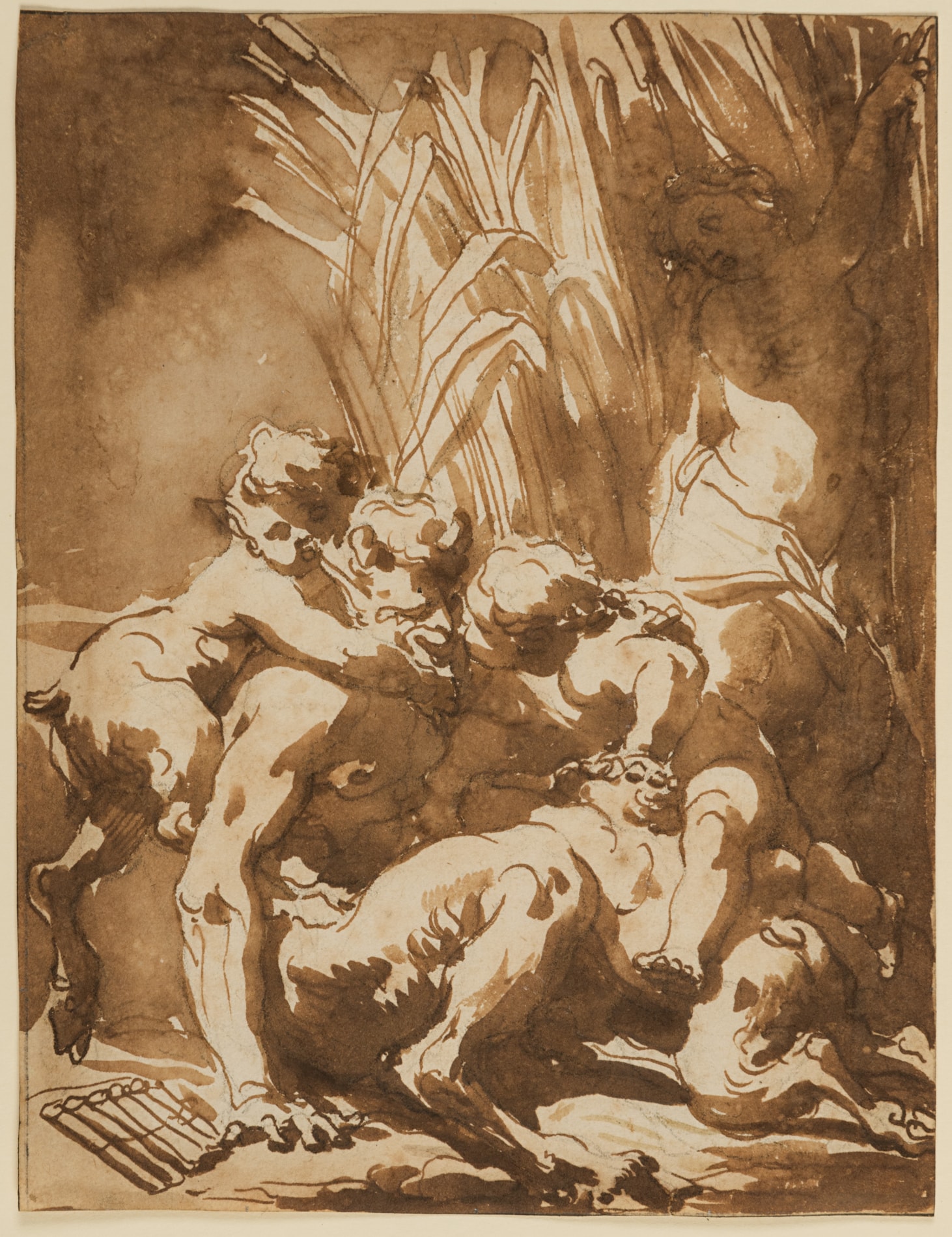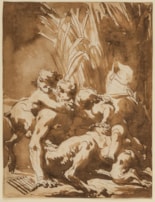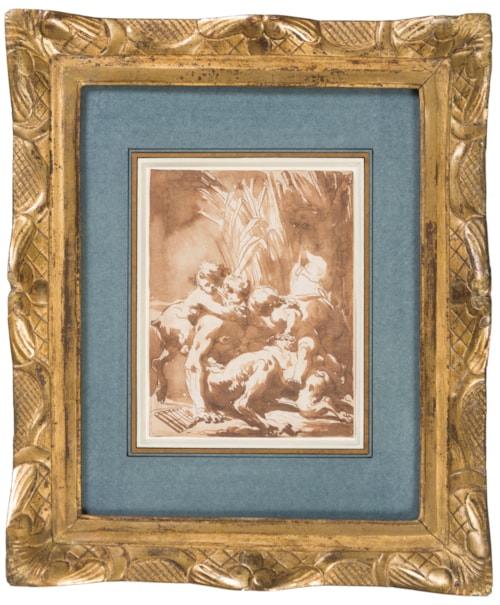Gaetano GANDOLFI
(San Matteo della Decima 1734 - Bologna 1802)
Pan with Young Satyrs, a Putto and a Nymph
Pen and brown ink and brown wash, over an underdrawing in black chalk.
Inscribed Drawn by Gaetano Gandolfi Bolognese painter on the former mount.
159 x 121 mm. (6 1/4 x 4 3/4 in.)
Inscribed Drawn by Gaetano Gandolfi Bolognese painter on the former mount.
159 x 121 mm. (6 1/4 x 4 3/4 in.)
This engaging little drawing is a splendid example of Gaetano Gandolfi’s lively and spirited use of pen and wash. Donatella Biagi Maino has noted certain analogies between the present sheet (which she describes as ‘di qualità superba’) and one of Gandolfi’s finest works as a fresco painter; the mythological scenes painted on the ceilings of the palazzetto of Conte Massimiliano Gini in Bologna, executed in 1772 with quadratura decoration by Barozzi. In particular, the lunette scenes of satyrs and putti frescoed on the lower walls of an alcove in the Casa Gini compare favourably, in their sensuousness and vivacity, with drawings such as the present sheet, as well as a similar study of a Satyr Chasing a Nymph (Pan and Syrinx) in red chalk, in the collection of the Biblioteca National in Rio de Janeiro.
A close stylistic comparison may be made with such drawings of mythological subjects by Gandolfi as two studies for a painting of The Triumph of Venus - one in a French private collection and the other in the Princeton University Art Museum in New Jersey - or a Judgement of Paris in a private collection.
A close stylistic comparison may be made with such drawings of mythological subjects by Gandolfi as two studies for a painting of The Triumph of Venus - one in a French private collection and the other in the Princeton University Art Museum in New Jersey - or a Judgement of Paris in a private collection.
Aside from trips to Venice in 1760 and Paris and London in 1788, Gaetano Gandolfi seems to have worked almost exclusively in his native Bologna, where he established a prosperous career. As a student at the Accademia Clementina he won two medals for sculpture and four medals for his drawings. A brief period of study in Venice in 1760 was of great importance, and is reflected in the vigorous brushwork and rich colours of his paintings. Gandolfi received numerous commissions for altarpieces for churches throughout Emilia and elsewhere, and also worked extensively as a fresco painter. One of his first important decorative projects was a ceiling fresco of the Four Elements, painted for the Palazzo Odorici in Bologna in collaboration with the quadraturista Serafino Barozzi. This was followed by work in several other Bolognese palaces, including the Palazzo Guidotti, the Palazzo Centurione and the Palazzo Montanari. In 1776 Gandolfi painted a massive canvas of The Marriage at Cana for the refectory of the Lateran convent of San Salvatore, now in the Pinacoteca Nazionale in Bologna. Another prominent commission was for the decoration of the cupola of the church of Santa Maria della Vita, painted between 1776 and 1779 with frescoes of The Virgin in Glory and The Sacrifice of Manoah. In the later years of his career Gandolfi also produced easel pictures of historical and mythological subjects, while a six-month stay in London and Paris in 1787 added a Neoclassical tinge to his oeuvre. Throughout his life he remained actively involved in the affairs of the Accademia Clementina, where he taught a class in life drawing. He was a gifted draughtsman, and his drawings were highly prized by contemporary collectors.
Provenance
F[rederic?] Maclellan Adami, Esq.
His sale, London, Christie’s, 29 June 1971, lot 124
Private collection
Anonymous sale, London, Sotheby’s, 7 July 1999, lot 49
P. & D. Colnaghi, London, in 2000
James Freeman, Kyoto
Stephen Ongpin Fine Art, London, in 2007
Private collection, New York.
His sale, London, Christie’s, 29 June 1971, lot 124
Private collection
Anonymous sale, London, Sotheby’s, 7 July 1999, lot 49
P. & D. Colnaghi, London, in 2000
James Freeman, Kyoto
Stephen Ongpin Fine Art, London, in 2007
Private collection, New York.
Literature
Donatella Biagi Maino, Gaetano Gandolfi, Turin, 1995, p.57, fig.XIX, p.75.
Exhibition
New York and London, Colnaghi, Master Drawings, 2000, no.28.







